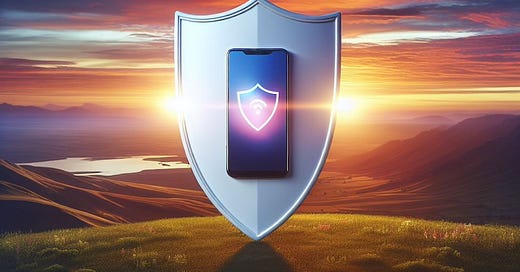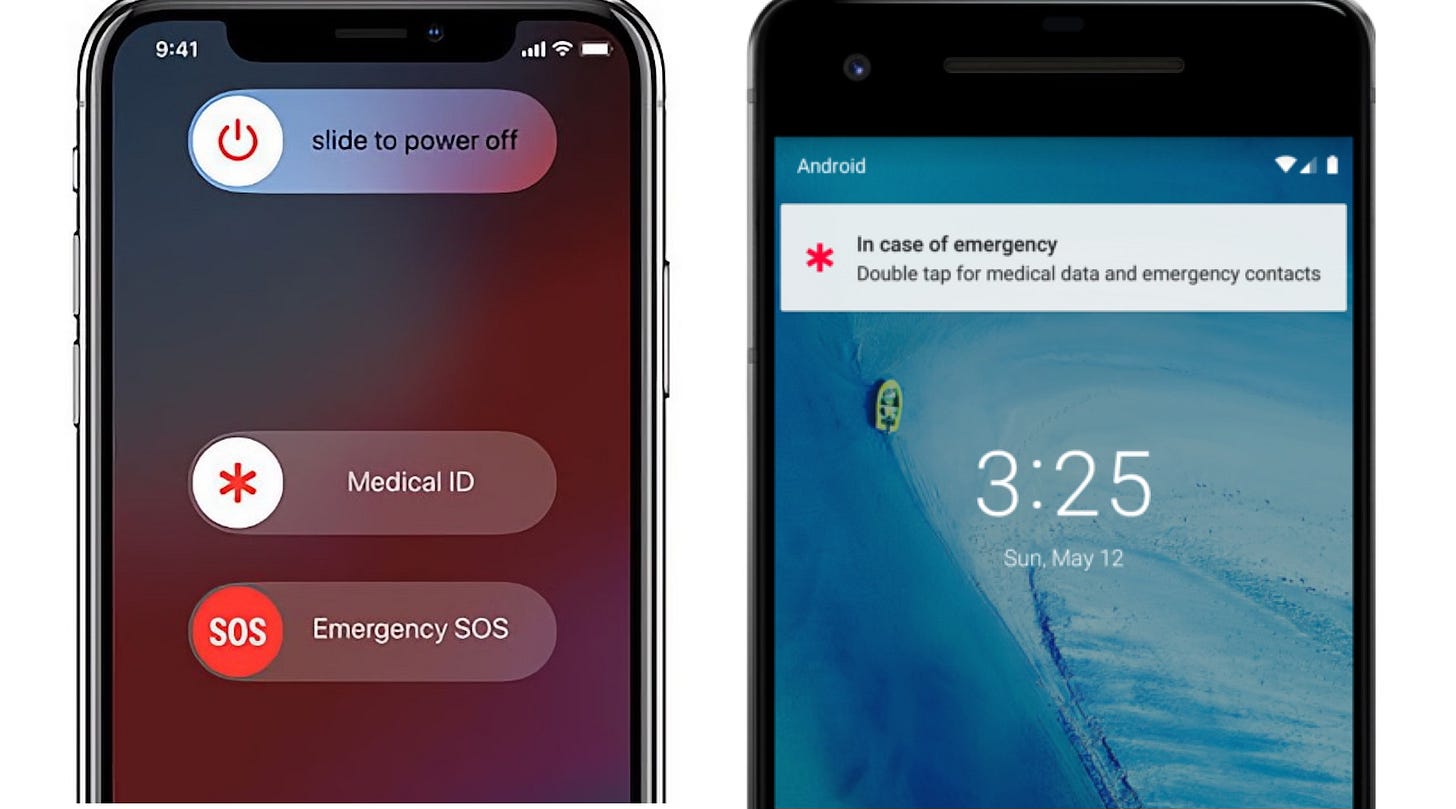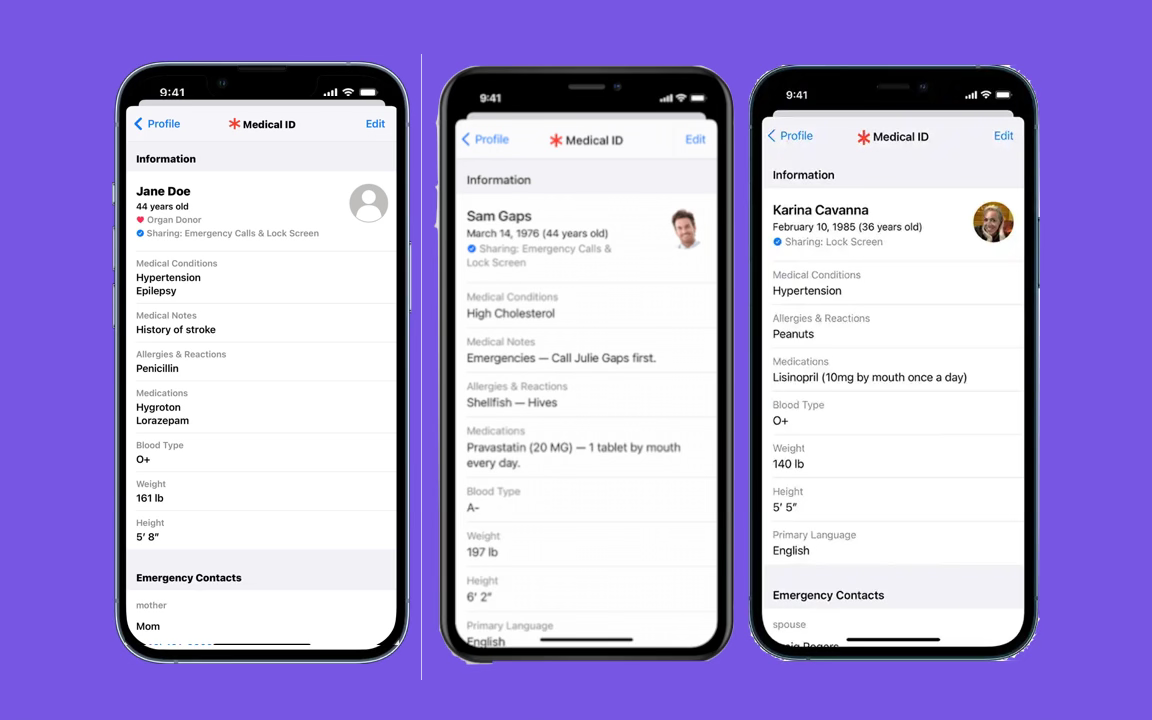Chapter 2: The Very First Thing You Should Do, Today
The easiest weapon against misdiagnosis is in your phone.
My mother had a serious health issue in Florida. I was in New York on the phone with the EMTs from the moment they showed up. They asked to see her phone. Her aide knew the drill and handed them two sheets of paper already printed out with her medical conditions, medications, and a list of her doctors. When they took her on the gurney to the ER, my mom held those papers plus her cell phone and a 10-foot-long cord. The hospital staff thanked the aide for being so prepared.
The number one cause of misdiagnosis is inaccurate or missing data. And you hold the key to fixing much of that in your hand or your pocket; your mobile phone. All smart phones have the ability to save your life by providing EMTs –– and you –– your essential medical history when you need it. It works whether you’re in your doctor’s office –– and need to give them a list of all your current medicines–– or if you’re lying on the street unconscious –– and the EMT needs to know if you’re on blood thinners or have cancer. All EMTs are trained to check your phone. So are all emergency department staff.
My husband and I have a mixed marriage; I have an iPhone and he has an Android. Yet, we were both able to set this up easily and they both work the same way.
In an emergency, your medical data on your smart phone is accessible to EMTs, Police Officers, and anyone else from your Lock Screen. They don’t require your phone’s passcode. On iPhones it’s called Medical ID; on Androids it’s called either Medical Info, Personal Safety app or just the Safety app. Google Play also has a free app you can download called Medical ID. Use these links to find directions on how to set it up on your phone.
There are 16 categories of information you may need to include. If you’re short on time, do just the first eight today. They take the least amount of time and are the most important.
Why might you want your doctor to have easy access to all your medical details? My father-in-law was on blood thinners. They carefully tested his blood regularly and for a time they couldn’t get his INR (a measurement of how quickly your blood clots) stabilized. It swung widely. As someone whose face had been on the receiving end of blood spurting from a small cut in his skin, I asked him a simple question. “Have you told your doctor that you’re taking ginkgo biloba?” It’s a natural over-the-counter supplement that claims to help improve memory. Whether it works is irrelevant. What my father-in-law hadn’t considered was that ginkgo biloba is a natural blood thinner that’s unregulated. The amount in each dose is inconsistent. He told his cardiologist, who hadn’t imagined that was the issue, and he was firmly instructed to stop.
Setting up the medical data on your smart phone –– and keeping it updated –– requires a little effort. But it’s not difficult and you can do it any random evening when you’re home. I sat at a table with all my prescriptions and vitamins and dictated the details into my note. I cut and paste my various doctors’ contact info. For surgeries, vaccinations, or anything where you can’t recall the date or it’s difficult to find, just estimate it.
There are 16 categories of information you may need to include. If you’re short on time, do just the first eight today. They take the least amount of time and are the most important.
Here’s what info to include:
Name. Include middle name or initial.
Birthdate.
Blood type. If you ever donated blood, that info is available on the card the Red Cross handed you. If you don’t know, ask the doctor’s office when they next take blood for lab tests.
Emergency Contact Name and Mobile Phone Number. (Also mark them in your contacts as ICE, which stands for In Case of Emergency.
Health Insurance Name, Member ID, Group Number, Contact Info.
Existing Medical Conditions. List every current condition you’ve been diagnosed with or the symptoms if you are still seeking a diagnosis.
Medication Allergies or Bad Reactions. This is super important to include. You can add if your reaction was anaphylactic (trouble breathing or swallowing), vomiting, rash, or something else.
Current Medications. Name, Dose, Frequency or if it’s taken As Needed. There are a myriad of reasons this is vital. Please be thorough and don’t skip any meds. If you just stopped taking something or switched from one to the other, list that here as well. Two reasons: 1. All medicine has side effects and 2. a single med or a combination of them can worsen existing or create new symptoms.
OTC (Over-The-Counter) and Supplements. Name, Dose, Frequency. Just because it’s not a prescribed drug, it’s still important, like my father-in-law’s ginkgo biloba. Vitamins, minerals, supplements and health drinks allimpact your bloodstream and they can mess up blood tests. We’ll discuss this when we cover prepping for tests.
Vaccinations, Name, Date. List if you’re up-to-date on your flu, tetanus, Covid, meningitis, measles, shingles and other vaccinations. If you have strong feelings about not getting vaccinated, write that down, too. It’s essential health information.
Surgeries. Type. Date. List all of them, even your tonsillectomy when you were little and you have to guess at the year. Include any major recent dental work since that can cause infection or affect your heart. If you had a recent surgical or chemical abortion, you might not wish to list it for legal reasons but if you were pregnant within two years of an emergency, it may be relevant. Pregnancy carries health risks as do miscarriages and abortions.
Preferred Pharmacy. I list both my local retail pharmacy and my mail-order pharmacy. This can also be usedby emergency personnel to double-check your current medications and allergies.
Pharmacy Benefit Manager (PBM), Member ID, RxBin Number, Phone Number. This is the medication insurance part of your health insurance. Part D if you’re on Medicare. It’s what makes it possible for you to get your medicines at a discount so you want it at your fingertips. They also have tons of your key medical data the emergency folks may need. If you don’t have a PBM, use your GoodRx number here.
Dental Insurance, Member ID, Group Number Lucky you, if you have dental insurance.
List of Physicians, Name, Specialty or Primary Care, Phone Number. I list all of them, even my ophthalmologist and dentist. Why not? It’s a handy reference sheet for me, and it's info your primary care doctor will want to know. If you don’t have a regular physician and use the local urgent care or emergency department for your medical needs, include the facility’s name and number since they will have your records in case of an emergency.
If you wear prescription glasses or contact lenses, include that info here.
That’s it. I use mine every time I see a new physician or check if a specialist has the most recent info. It’s so much easier to hand or send them the info than to squeeze it into the tiny space they give you on the clipboard. The staff appreciates it because they –– like everyone else I know –– can’t read my handwriting. If your medical practice requests you fill out the forms online in advance, do it! You can copy and paste the details or add the medical ID details as an attachment.
Please share this with your partner, family members, and friends. It’s the easiest way to protect ourselves from a misdiagnosis, whether it’s an emergency or a scheduled medical appointment.
Next up: Chapter 3: I Just Want To Feel Better. What Is A Diagnosis and Why Does It Matter?
© Helene M. Epstein, 2025









I've been seeing that "Medical ID" thing on the lockscreen for years and never thought about it! This is brilliant as usual. Thanks, Helene.
It's so important to have this information handy on your phone! Thanks for another helpful article, Helene!